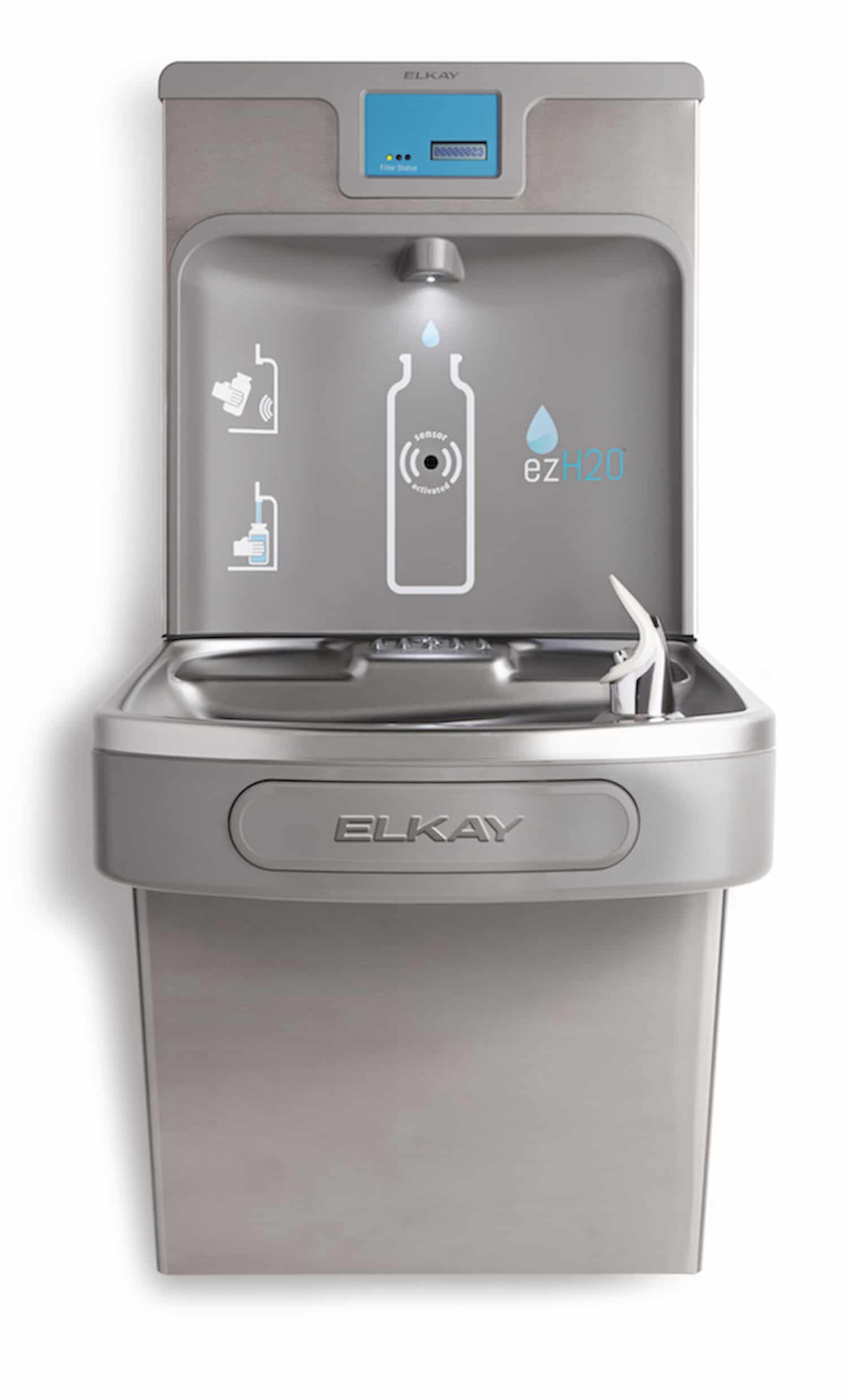The public drinking fountain is a particularly linear and straightforward machine. It’s designed to carry out one specific task and deliver one specific resource. They are practically as ubiquitous as they are necessary, and the notion of expanding upon or modulating their use seems to have never been worth considering—until Elkay noticed a void that needed filling. We spoke with the company’s own Ellen Sajdak, product manager, bottle filling stations, to learn more.
gb&d: Public drinking fountains are practically as old as most of the institutions that deploy them. What inspired the development of this product, and why do you think it took so long for the demand to build for such a seemingly obvious convenience?
Sajdak: Drinking fountains are required by plumbing code in all commercial and public buildings with few exceptions. And in areas where drinking fountains are required, they must have two heights to meet both the adult and child heights to comply with the Americans with Disabilities Act. Elkay began production of Pressure Coolers back in 1969 and has grown by introducing new styles and designs of the simple drinking fountain since then. As it relates to the bottle filling stations, the team began working on that concept in 2008 and it was launched in the market in 2010. The team saw the concept as possibility after watching people interact with our products and a need that was missing in the market place. Bottle Filling Stations provide an easier and more convenient way to interact with a drinking fountain when trying to fill a bottle or container.

gb&d: At first, it might seem to some that filling up bottles of water rather than just snatching a sip in passing would demand more electricity and more water consumption. What are the specific ways in which the Elkay ezH2O is a net gain for sustainability?
Sajdak: Actually, sipping water from the bubbler on a drinking fountain allows for the water to run down the drain as well as going into your mouth. By using a bottle filling station, the laminar flow on our units allows for the water to go directly into your bottle, thereby capturing all the water that is being dispensed. With regards to the electricity and energy usage by the units, it’s fairly minimal compared to other items in the facility. Our testing shows that running a cooler and bottle filler, on average, uses $44 annually. The bottle filling stations allow for reusable bottles to be filled quickly and easily, allowing the end user to avoid purchasing a disposable plastic bottle. Our new platform of bottle filling stations has an option to power down the refrigeration on the units while continuing to dispense water. This allows for facilities to power down the chilling option on the units on the weekends or times when the building is not being used to save even more energy with the units.
gb&d: College students and faculty members are among the most conscious and proactive when it comes to protecting the environment. Have you noticed an extraordinary receptiveness from college campuses in terms of the ezH2O? Where else has the product seen an enthusiastic welcome? Has it run into difficulty or skepticism from a particular industry?
Sajdak: Regarding receptiveness from college campuses, yes, we have seen a tremendous acceptance from that community. They have been some of the early adopters and in addition, those end users also have a great willingness to provide us feedback on the units. We have also seen a wide acceptance from a variety of other industries – airports, corporate campuses, outdoor parks & stadiums just to name a few! Some facilities have been hesitant to provide bottle filling stations to consumers because they were concerned about disrupting sales of bottled water but we have heard feedback to the contrary on that issue. Some sites have actually seen an increase in their bottled water sales after the installation of the bottle filling stations.
gb&d: We were reading about your New Mexico State University case study, wherein the campus encouraged students to fill their own bottles, which truly became a success after students rallied for the ezH2O. Prior to that, frustrations with using conventional fountains to fill water bottles predominately concerned ergonomic discomfort. How important of factors do you think ergonomics, convenience, and comfort are when trying to steer the public down a sustainable path?
Sajdak: I would say that there are additional issues that stemmed from using conventional fountains to fill a water bottle; spilling water on the floor and all over the user is a frustrating thing to the user, in terms of wasting water and the mess created. Certainly a bottle filling station allows for easier use and filling of a bottle versus a standard bubbler on a drinking fountain. Elkay does everything we can to make a sustainable product just as convenient and easy to install, easy to use, easy to interact with as a more traditional stand-alone drinking fountain type product.
gb&d: It’s significant that an ahead- of-the-curve enterprise like Elkay is an American-owned company. We know that a handful of European countries share a commitment to environmental sustainability. How has the product fared as a global export?
Sajdak: The Bottle Filling Stations have been well received internationally as well as domestically. We have seen many regions and countries understand the value the units can add to a public facility as well as the end consumer. The units have been installed in a number of highly visible locations domestically, including Harvard University and O’Hare International Airport. Internationally, even beyond Europe, we have units installed at the Hong Kong International Airport and the National Stadium Bird’s Nest in China, as well as the Centennial Park in Australia.

